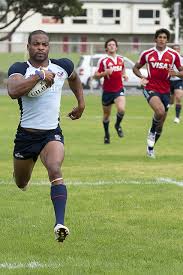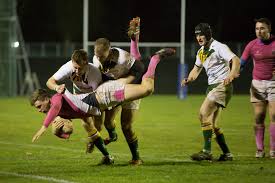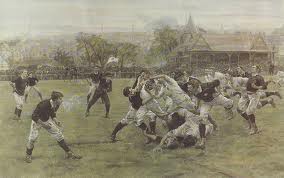Strength and Power in Rugby: Part 3
1 Comment The Rugby World Cup is in it’s knockout stages. National Fitness adviser Simon Worsnop looks at current strength and power measurements.
The Rugby World Cup is in it’s knockout stages. National Fitness adviser Simon Worsnop looks at current strength and power measurements.
Strength and Power Levels
Since the onset of full time professionalism in both sports strength levels have increased so that today’s players possess higher strength levels than similar aged recreational players
e.g.” the trained junior high school RL, senior high school RL College RL and NRL players are capable of lifting approximately 102, 115, 124 and 148% of their body mass, respectively, in the 1RM bench press” (1)
Players also exhibit far higher levels of strength than in previous years e.g. 1RM bench press scores for Professional RL players in January 1993 were 113.1 for backs and 119 for forwards (2) and in 1996 O’Connor (3) reported scores of 106kg for backs, 100.1 for halves, 112.4 for back row, 123.4 for props and 99.7 for hookers; whereas Baker reported an average of 134.8 in 2001 (4) and 142.7 across all players in 2004 (5).
Professional players also exhibit higher power levels e.g. NRL players were significantly more powerful in every variable measured (than student RL players) (6).
The load at which the Pmax (maximum power) occurred was also significantly higher in the NRL players. This has particular relevance to the tackle area where the more experienced player is likely to be more powerful against the bodyweight of an opponent than is the novice player. Baker (7) also suggested that “results indicate that the difference in power output between teams of different playing levels may depend largely on differences in maximal
strength.”
As players become more experienced their strength training focus
changes, as the players become stronger they have probably adopted the strategy of increasing power initially by increasing the absolute load while maintaining movement speed. However, once a base level of maximal strength has been attained and further large gains in strength are less likely to occur, it may be difficult to increase power by increasing the Pmax load; rather, power is increased by increasing the speed at which each load is lifted. (8)
Benchmarks for younger players
Players in the England U20 team can squat over 220kg, bench press approaching 200kg and power clean 160kg. Individual players at U18 level can bench press 135kg for 5 repetitions and one player can squat 200kg for this number. Now, this does not mean they are necessarily good rugby players, nor does it mean that they can transfer this force to the field- they may “train like Tarzan and play like Jane.”
What this does show is how the strength levels of modern rugby players are escalating. This does not say that an eighteen year old player with poor strength levels cannot “make it” at top level; in fact if he is succeeding at age group rugby despite poor strength levels it could be argued that he has a greater chance. However in order to protect his body and compete in the collision in the modern game he would have to undergo a long term rigorous, planned strength development programme.
How can I get strong for Rugby?
Strength levels are improved in the gym by the use of the major multi joint lifts used in Powerlifting and Olympic Weightlifting as well as other more rugby specific rotational and “Strongman” type lifts.
For a player, and hence a team to be successful specific partner bodyweight exercises around the tackle, ruck, maul and play the ball must also be practised as well as the supporting exercises derived from wrestling and grapple sports; these type of exercises were thought to be significant by Baker in contributing to the increase in power for NRL players throughout a one year period (9).
To be successful, all of these forms of strength training must form part of the practice week even for the recreational player. And young players should be following an age- specific long-term athletic development programme.
Some of the rugby and grapple exercises will be practised “bone on bone”, others will involve players with tackle suits. Exercises using tackle shields, tackle bags and wrestling dummies can also be used.
Conclusion
Because the collision is such an important part of the game we now longer see the “cup upset”. In soccer, though a team is clearly better it does not necessarily win a game and a club from the “lower reaches” will occasionally pull off a “cup upset”.
This used to happen in both codes of rugby on a yearly basis, but now this is almost unheard of. This is almost certainly due the greater intensity of the collision and the variation in strength levels between the two teams. Though TV commentators on such games between teams from different divisions often say, “the higher fitness levels prevailed in the end” they are missing the point as cardiovascular fitness levels will be similar.
Skill and decision making levels will be different, but the major discriminators will be size and strength- the team that is weaker and 5-10kg a man lighter or significantly physically weaker will in the end succumb because of the importance of the collision
See our Get Stronger programme here
References
1: Differences in Strength and Power among Junior-High,
Senior-High, College, and Elite Professional Rugby League Players Daniel Baker JSCR 2002, 16 (4), 581-585.
2:(Evaluating players fitness in Professional Rugby League Rudi Meir Strength & Conditioning Coach 1 (4) 1993
3: (Strength & Conditioning Coach 4 (1) 1996)
4: (Comparison of Upper Body Strength and Power between Professional and College-Aged Rugby League Players Baker JSCR 2001 15(1) 30 -35)
5: (An analysis of the ratio and relationship between upper body pressing and pulling strength JSCR 2004 18(3), 594 – 598).
6: Comparison of Upper Body Strength and Power between Professional and College-Aged Rugby League Players Baker JSCR 2001 15(1) 30
-35.
7: (A Series of Studies on the Training of High Intensity Muscle Power in Rugby League Football Players JSCR 2001 15(2) 198 – 209
8: (Comparison of Upper Body Strength and Power between Professional and College-Aged Rugby League Players Baker JSCR 2001 15(1) 30 -35).
9:(Comparison of Upper Body Strength and Power between Professional and College-Aged Rugby League Players Baker JSCR 2001 15(1) 30 -35)


 Strength and Power in Rugby
Strength and Power in Rugby Now, before old timers from both codes shout me down I am not saying that yesterday’s players were anything but skilful, aggressive and tough and I am not arguing that the games are better now than then.
Now, before old timers from both codes shout me down I am not saying that yesterday’s players were anything but skilful, aggressive and tough and I am not arguing that the games are better now than then.